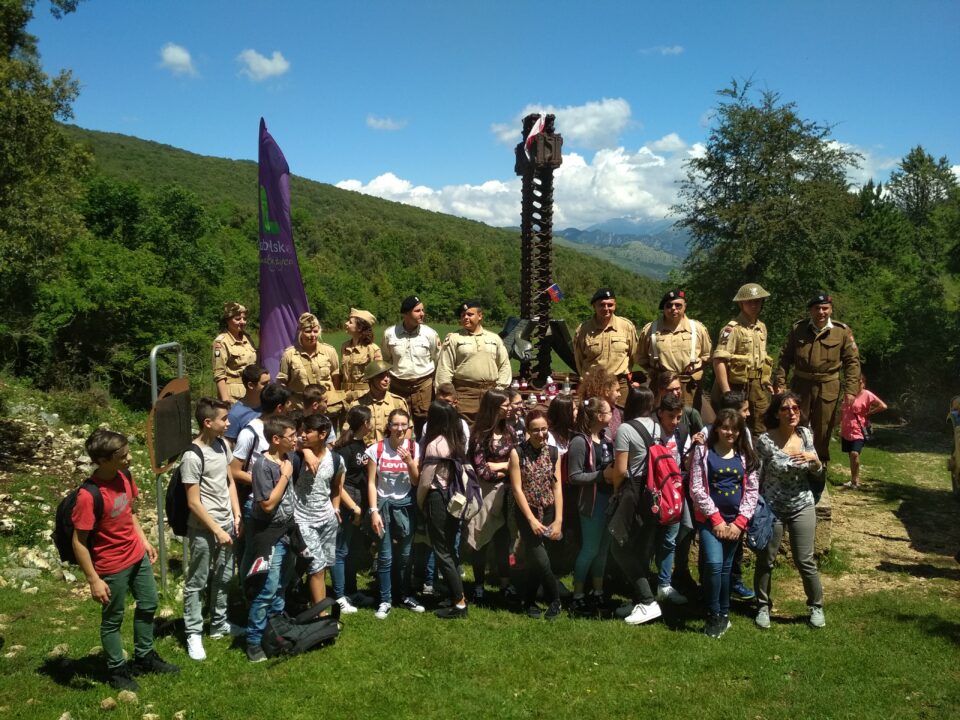
Monte Cassino Battlefield tour for Poles: HISTORICAL BACKGROUND
Monte Cassino Battlefield tour for Poles: why they were in Cassino Area
When I’m working as a Tour Guide on the WW2 Battlefields of Monte Cassino, people are sometime asking me why the Poles took part to the battle, and what they did. The Battle of Montecassino is so well know by the Poles because it is one of episodes of the Second World War, marked by bravery and success. In every article or book on the Italian Campain, there are some lines dedicated to Monte Cassino and what happened here 73 years ago. The Italian Campain lasted from July 1943 to May 1945.

Monte Cassino Battlefield tour for Poles: the arriving of the II Polish Corps
First of all, the Allied Forces landed on Sicily and they were successful because the German reinforcements arrived too late. The Polish II Corps did not take part in the Sicilian operation because in July-August 1943 the Poles were still in the Middle East. Then the Allies landed in Italy, the American were direct to Cosenza and Neaple, while the British were sent to east, to Taranto, Foggia and Termoli. German tactics were very clear. They wanted to slow the Allies down and to inflict them with the maximum amount of casualties. The II Corps began to arrive in Italy at the end of December 1943. They were sent to the training centre of San Basilio, but their first introduction to the sunny Italy started in the mud and the snow.

Monte Cassino Battlefield tour for Poles: the Polish Corps in South Italy
The base camps were established near Bari and Brindisi, far away from the first line, but always under a lot of rain and snow. The transfer from Egypt to Italy took several weeks, and the integration in the British VIII Army was difficult. The British VIII Army was like a collage. In Africa it war formed mainly by British, Indians and Commonwealth regiments, but in Sicily the “Free French” were added, and between them the most numerous part were Algerians, Maroccans, Madagascans and even Tahitians. Even the Poles were familiar with multi-ethnic societies. they themselves included Poles, Belarusians, Jews and Lithuanians.

The Polish order de battle
The Polish order de battle was very simple:
3rd Carpathian Infantry Division
5th Kresowa Infantry Division
2nd Armoured Brigade
General Wladyslaw Anders controlled 15-20 percent of the VIII Army’s strength. Among the twenty divisions which participated to the Italian Campaign three were depended on exiled governments based in London. The French Expeditionary Corps with 112.000 men, the Polish II Corps with 55.000 men and the 3rd Greek Mountain Brigade with 18.000 assigned to the British 13 Corps. We must remember and other very important thing the Poles shared with the Canadians: both of them have to participate to the war without being represented in the strategic conferences. All the decisions were taken by the “Big Three” America, UK and Soviet Union.

General Anders and his men are asked to fight in Cassino area
General Leese, commander of the VIII Army asked Anders on 24 March 1944 if the II Corps could participate to the coming battle, even if it was clear to Anders that his men were still very weak to fight, but he also knew that if he had declined, he could have seriously damaged the reputation of the Polish Corps. When he arrived next to Cassino, he had already a lot of information about what had already happened there, and the mistakes the Allied had already done.
On 11 May 1944, General Wladyslaw Anders issued his Order of the Day:
“Soldiers!
The moment for the battle has arrived. We have long awaited the day of revenge and retribution over our hereditary enemy. Shoulder to shoulders, will fight British, American, Canadian and New Zealand divisions, together with French, Italian and Indian troops. The task assigned to us will cover with glory the name of the Polish soldier all over the world. At this moment, the thoughts and hearts of our whole nation are with us. Trusting in the Justice of Divine Providence, we go forward with the sacred call in our hearts: God, Honour, Country”
While two British corps were to surge forwards on either side of them, and the I Canadian Corps had to cross the Liry Valley, the Poles were asked to take the Monastery Hill by frontal attack. The first Polish assault on 12 May was unsuccessful, but in the early hours of 18 May, when elements of the 78th British Division joined the Polish unit, a red and white flag was raised above the ruins. At midday, Master Caporal Emil Czech raised his bugle to sound ” St Mary’s trumpet Call” to signal the Victory. The telegram which General Wladyslaw Anders sent to his Commander-in -Chief General Sonkowsky was really clear : “….Victory due to heroism of soldiers….”
On 25 May, Polish units burst through the Gustav Line at Piedimonte San Germano.
But from this point starts another story, your tour guide will tell you when you will visit us…

The Poles have a special place in Cassino history. The 2nd Polish Corps numbered about 50.000 men, all of whom had a long and dangerous journey behind them, started in Syberia and ended in Europe. The Katin massacre had already taken place, and General Anders got with great difficulty the permission to organize two divisions and a reserve regiment. Lieutenant-General Wladyslaw Anders had now the hard task to command the 3rd Carpathian Rifle and the 5th Kresowa Infantry Divisions supported by the Polish 2nd Armoured Brigade. In mid-December the 3rd Carpathian Division arrived in Taranto and entered the line on the Adriatic Coast as part of the British Eightth Army. The rest of the Army had followed by the end of February. In mid-March 1944, the Lieutenant -General Leese briefed Anders on a possible role for the Polish Corps in capturing Monte Cassino heights and then the Village of Piedimonte. Even if the Polish attack on 12 May failed, on 16 May Colle Sant’Angelo had been captured by the Kresowa division and the next day the Carpathians moved again against Point 593

(Photo NARA)

(NARA MM-5-44-2037)

(Photo Signal Corps/NARA)
At about 08.00 am. 12 Poles approached the monastery through the minefields, no shot were fired and seventeen German Paratroopers emerged from the rubbles. Shortly afterwards, Section Leader Czech played the Krakow Hejmal, a medieval Polish military signal on the bugle, and the Polish flag was blowing on the top of the ruins. The Battle of Montecassino was at an end. The slopes of the hills, particularly where the fire had been less intense, were covered with poppies in incredible number….
Thanks to War Memories-Memorie di Guerra for the old pictures



Dive into the heart of Montecassino and its Polish heroes’ story!

Monte Cassino Battlefield tour for Poles: WHAT TO EXPECT
The “Monte Cassino Battlefield Tour for Poles“ (about 3 Hours) includes:
1) pickup from your arrival at the railway station in Cassino every day at 10.00am or 02.00pm (Main Square, near the Green Kiosk)
2) about 3h30 guided tour of the Polish most meaningful sites of Cassino:
- The Polish War cemetery
- Point 593 and the Polish Obelisk (it involves some walking)
- The Polish Tank (it involves some walking)
- The Cavendish Road (it involves some walking)
- The Albaneta Farm and the view on the Kresowa Cross
- Montecassino Abbey
- The Statue remembering General Anders
- the Statue of Wojtek the Bear
3) return to the railway station in Cassino at 01.30pm or 05.30pm

Monte Cassino Battlefield tour for Poles: WHAT YOU MUST KNOW ABOUT THIS TOUR
WHEN AND WHERE: At the railway station in Cassino every day at 10.00am or 02.00pm (Main Square, near the Green Kiosk)
WHAT IS INCLUDED: Minivan and ww2 tour guide
WHAT IS NOT INCLUDED: Lunch and dinner are not included but I can suggest…
PRICE PER PERSON: 80 euros (lunch or dinner not included)
GUIDES/LOCAL EXPERT: I will held this tour.





Monte Cassino Battlefield tour for Poles: MORE TOURS IN THIS AREA
“Countdown to Cassino” Grand Battlefield Tour ⭐⭐⭐⭐⭐
“Battle for Rome” Grand Battlefield Tour ⭐⭐⭐⭐⭐


